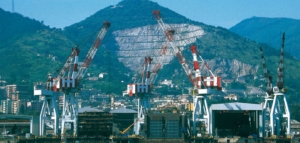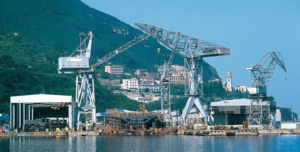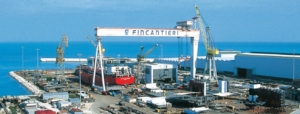Fincantieri – business at the docks. Italian Style



 By Marek Grzybowski
By Marek Grzybowski
Revenues of EUR 3,669 million and an increase of 4.5% compared to H1 2022. EBITDA of EUR 185 million, with an EBITDA margin of 5%. FINCANTIRI GROUP has an order book for 88 ships and ships worth EUR 22 billion. This is joined by orders for projects, systems and equipment. The entire portfolio of contracts at the end of June this year reached worth EUR 34.2 billion. This is the shortest review of the possibilities of one group of shipyards in European realities. The Fincantieri Group Management Board has announced the results for the first half of 2023.
The Polish shipbuilding industry, with its assets still not fully used, has a chance to appear on the market if it draws conclusions from the activities of the same industry in other countries, such as Italy.
Fincantieri is a brand with over 230 years of history, although the history of Italian shipbuilding, or rather boatbuilding, dates back to Roman times. Many of the Fincantieri Group’s shipyards operate in historic locations in Italy, as well as in Norway, the United States and Brazil.
The Polish transatlantic ships TSS Piłsudski and TSS Batory were built in the docks of Monfalcone, belonging to the Cantieri Riuniti dell’Adriatico shipyard group.
19 thousand employees work in 18 shipyards and in a structure reminiscent of the Polish shipbuilding industry in its heyday.
Nationalized in 1959, Fincantieri, based in Trieste, remains on the market despite the turmoil in the European shipbuilding industry. The Group underwent a number of transformations and adapted to the needs of the market, diversifying its offer and entering new markets.
Acquisitions and innovations
One of the spectacular acquisitions was the incorporation of the American shipyards Manitowoc Marine Group (MMG) into Fincantieri – Cantieri Navali Italiani. The Italian group acquired the shipyards from Lockheed Martin Corporation for approximately $120 million in cash. Lockheed agreed to be a minority shareholder. In this way, Fincantieri entered the booming US market of shipbuilding and units for the coast guard.
In the middle of this year, newcleo signed a contract with Fincantieri. The British company based in Manchester is a manufacturer dealing in clean and safe nuclear technology. It offers innovative 4th generation reactors that use nuclear waste as fuel. RINA (Inspection, Certification, Classification of Ships and International Engineering Consulting) is also a contract partner.
The three companies are pooling their expertise to jointly conduct a feasibility study for nuclear reactor applications in the marine industry, including Newcleo’s Small Modular Reactor (SMR) technology. The Fincantieri Group builds its competitive advantages on the development of innovative and forward-looking projects.
Italian backlog and luxury ships
88 ships worth EUR 22 billion are in production and are to be delivered to shipowners by 2029. In the first half of this year. 11 ships from 8 shipyards were handed over to shipowners and it is planned to hand over 4 cruise ships in the second half of 2023.
The strategy of focusing on innovation and high quality brings results. In June this year Fincantieri managers signed a contract with Marc-Henry Cruise Holdings LTD, co-owner and operator of Four Seasons yachts, for the construction of a second ultra-luxury vessel.
The contract is worth over EUR 400 million, and the ship will be completed by 2026. In 2022, Fincantieri won an order for the first ship of this class, which will be handed over to the shipowner in the fourth quarter of 2025.
Naval and offshore ships
In this year also received a new contract for the fourth unit of the Constellation program (FFG-62) for the US Navy, awarded to the US subsidiary of FMM. In July, an order was also obtained for the third submarine of the U212NFS (Near Future Submarine) program for Marina Militare – the Italian Navy.
In the first half of this year delivered the fourth and final Semaisma corvette to the Ministry of Defense of Qatar and LCS (Littoral Combat Ship) USS Marinette to the US Navy.
– The Group’s portfolio includes contracts for 8 CSOV units: 4 units for Edda Wind with an option for 4 additional units, 2 for North Star with an option for 2 additional units, 2 for Purus Wind with an option for 2 additional units – informs the management of Fincantieri Group in the semi-annual report.
The Norwegian shipyards of the Fincantieri Group have delivered 7 ships, including 4 CSOVs. Two units took delivery of North Star Renewables, one Rem Wind and one Norwind Offshore. The ship of the Norwegian Coast Guard entered service. The Marine Robotic ship was picked up by operator Ocean Infinity. And it doesn’t end there.
The complete order book of the Fincantieri Group
In total, Fincantieri’s order backlog in the first half of this year increased by EUR 2.1 billion compared to EUR 1.5 billion in the first half of 2022. This was mainly due to the orders of luxury ships, navies and operators operating in the Wind Offshore market and specialized vessels. As a result, Fincantieri’s shipyard workers are guaranteed lucrative contracts worth EUR 482 million.
The activities of the Fincantieri Group are an example of how the domestic shipbuilding industry can be transformed into a well-functioning industry. The Italian group flexibly adapted to the needs of the market, entering foreign markets with innovative, own projects. As a result, Italian shipyards were able to maintain workforce and modernize production at higher costs than in Poland.
Today, almost 30% of revenues are generated by the production of ships for offshore and specialized vessels (exactly 27.9% in June this year). Romanian shipyards are also profitable, where the production of cruise ship sections is located. The segment including the production of accessories for ships and ships, systems and other equipment for ships and ships increased by 45.8%. As at June 30, 2023, 83% of revenues were generated by foreign customers.
Much is said about the development of shipbuilding in Poland. In the industrial zones of Gdańsk, Gdynia, Szczecin and Świnoujście, there is still room for domestic and export production. After all, for many European countries it is still a profitable business. Maybe it’s worth taking a look at how the Italians use the potential of ship and ship production, and then adopting some solutions in Poland?
